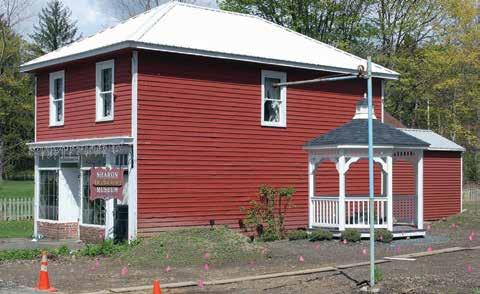
3 minute read
Self-Care with Chelsea CORNER
What’s your favorite self-care practice during summer?

Advertisement
I’m the type of summer person who cannot get enough sunshine, but all that heat can be overwhelming to the system, so my favorite self-care summer activity is to spend a leisurely day by a body of water. Gilbert Lake is a local favorite, with lots of walking trails, water activities and my personal favorite – no cell phone service. I pack cooling essentials, like watermelon and homemade limeade, and sit back to enjoy some unplugged, unscheduled time.
What inspires you about your work? What are the challenges?
I love the opportunity to share about something that has radically changed the way I live. You can take a yoga class and enjoy the physical benefits without ever diving deeper, but I truly feel all the teachers at Yoga People Oneonta live their yoga and share this passion from a deep desire to inspire others to do the same. It’s inspiring to see these changes in real-time, as we witness clients prioritize their own wellbeing and all that they’re able to accomplish by doing so. As the saying goes, when one teaches, two learn. As guides and teachers, we have the opportunity to learn each and every day, forging deep connections with our community members. As with all things, it doesn’t come without challenge. We’re still recovering from lockdown and, while things have been wonderful this year, there are a lot of changes that still limit our reach and accessibility. Yoga as an industry is a bit of a paradox to start with, so it is always challenging to balance all the moving parts that keep our doors open and our heat on, while staying aligned with our values. how can people learn more about yoga people oneonta?
We’re fairly active on our Instagram and Facebook pages, @yogapeople_oneonta, and our website is updated in real-time with class offerings and events at yogapeopleoneonta.com. The best way to see what’s going on with us is to stop in and say hello at 50 Dietz St. Suite L in Oneonta. +
Nearly 200 years ago, Sharon Springs became a destination place for visitors wanting to take advantage of its “healing” sulfur waters.
Once the Erie Canal was opened in 1825 and the value of the waters was discovered, it was only a short stagecoach ride from Palatine Bridge to Sharon Springs. From 1836 to 1860, several large hotels were built to accommodate the increasing number of visitors to the village. Since the 1950s, the resort destination went into decline. Recently, there have been onagain, off-again efforts to revitalize some of the old bathhouses on lower Main Street. Other buildings were lost to deterioration and fires. And recent success stories of reopening some of the grand hotels have come about slowly.
But Sharon Springs has new reason to be optimistic about preserving its past, through reuse of some of the older, unused buildings near the property of the Sharon Springs Historical Society Museum, 238 Main St.


Through work underway by the society, there will soon be a new “old” general store, post office, doctor’s office, barber shop, millinery and dress shop, print shop, Jewish synagogue, ice-cream shop, church and a much larger museum building – all ready for viewing this summer.
Next door and behind the present museum at 238 Main St., there was a series of small guest cabins, long since abandoned, now being repurposed to house these new shops and places of worship. A typical cabin included a small kitchen, bathroom and two beds.
According to Ron Ketelsen, president of the Sharon Springs Historical Society since 2021, “Restoring these cabins has taken a lot of work and has included some changes in roof lines, putting in large glass windows for viewing and general facade improvements.” The cabins were structurally sound, but needed extensive refurbishing, he said. The cabins looked much alike at the start, but the refurbishing work will give each a unique appearance when completed.
Also behind the village-in-progress is a former boarding house on Center Street called the Ganz House, built in 1927. The historical society has purchased it and will reimagine it as home to the new main museum.
“We don’t have much room in the current museum,” Ketelsen. “(Ganz House) has four floors. We’re going to add a wrap-around, Victorian-style porch to it. The existing museum will become a welcome center and gift shop. Visitors will access the historic village and, in time, be able to enter the larger museum and all its exhibits.” Ketelsen expects the museum on Center Street to open by 2024 as it, like the cabins, needs to be cleared out and refurbished.










